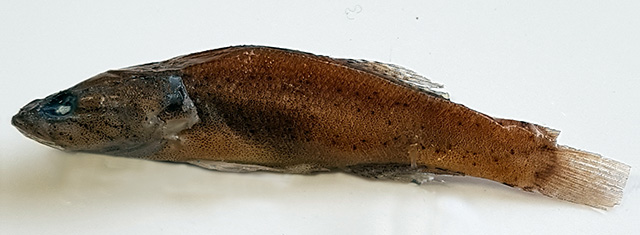|
Dorsal spines (total): 7-7; Dorsal soft rays (total): 8-9; Anal spines: 1-1; Anal soft rays: 8-9. Diagnosis: Eleotris sahanaensis is distinguished by second and fourth suborbital free neuromast rows on cheek extending ventrally past horizontal row 'd' ('2.4' pattern), row 'os' not connected with row 'oi' at ventro-posterior margin of operculum ('open' pattern); 15 pectoral fin rays; no teeth on vomer; 54-55 scales in lateral series and 29-30 scales in predorsal series (Ref. 123271). Within the pattern '2.4' group, E. sahanaensis differs from E. acanthopomus in having 15 pectoral fin rays vs. 16-17, 10 scales in zigzag series vs. 11-14, and 29-30 scales in predorsal series vs. 30-42; it differs from E. vomerodentata by the absence of teeth in the vomer vs. presence; it differs from E. pellegrini by a smaller head length, 30-32% of standard length vs. 31-37%, and fewer scales in zigzag series, 10 vs. 10-12 (Ref. 123271). Description: The body is elongated; the body depth at anus is 16-22% of standard length and the caudal peduncle depth is 11-12% of standard length; predorsal length 46-47% of standard length and preanal length 61-63% of standard length (Ref. 123271). The head 30-32% of standard length is broad and depressed, the snout is pointed; eyes high on head; the mouth is quite large, as jaw length 9-11% of standard length, and oblique, the posterior margin of upper jaw reaches the vertical through the two thirds of the eye; upper and lower jaws with multiple rows of small inwardly curved teeth (Ref. 123271). Dorsal fins VI-I,8-9; first dorsal fin spine separate from and smaller than second dorsal fin spine; spines not enlarged; anal fin I,8-9 and directly opposite to second dorsal fin; pelvic fins separate, I,5; pectoral fins 15; caudal fin pointed with 15 branched rays (Ref. 123271). Cycloid scales on top of head, nape, cheek, operculum, pectoral fin base, prepelvic region, and abdomen; ctenoid scales covering flanks; no lateral line canals; 54-55 scales in lateral series, 29-30 in predorsal series, 14-15 in transverse back series, 19-20 in transverse forward series and 10 in zigzag series (Ref. 123271). A downward pointing spine at the posterior margin of the preoperculum is covered with skin; gill opening is moderately broad, extending to below the preoperculum; tubular anterior nares overhanging half upper lip, posterior nares open pits (Ref. 123271). Adults with five transverse suborbital free neuromast rows of which second and fourth suborbital free neuromast rows on cheek extend ventrally past horizontal row 'd' ('2.4' pattern); row 'os' not connected with row 'oi' at ventro-posterior margin of operculum ('open' pattern) (Ref. 123271). Urogenital papilla elongated and tapered in male (Ref. 123271). Colouration: Colour in life unknown (Ref. 123271). Colour in preservation: head and preoperculum greyish, finely spotted and with 3-4 oblique brown lines from the eye to the edge of operculum; back brown, flanks light brown with numerous dots more or less aligned from the operculum to the hypural; a big blackish area at the anterior part of the flanks, below the medial part; abdomen and gular region whitish to yellowish and finely spotted; a black dot at the base of the pectoral fins; anal and second dorsal fins with 3-4 dark horizontal bands alternating with 3 small white ones; caudal fin greyish, with 2-3 small spots anteriorly; pelvic fins whitish (Ref. 123271). |

